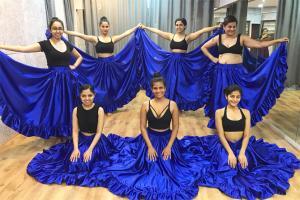Not many would know that veteran actor Kitu Gidwani is a trained dancer too. The artiste on being part of India's first all ladies Afro rumba performance and her love for the art form

Tell us about how you developed a love for dance
My history with dance is chequered. As a child, when I watched someone in my building do Bharatanatyam, I told my mother I wanted to learn it and did so for a few years. Later in life, I came across Padma Shri Dr. Ileana Citaristi, an Odissi and Chhau exponent, under whose guidance I learnt Chhau. I also joined Shiamak Davar’s academy and in 1999, started doing serious Latin ballroom dancing with Sandip Soparrkar. Having learnt the Argentine tango for 12 years, it is a dance form I am a senior artiste in. And now, my love for Cuban and African music took me to a workshop by choreographer Namrata Wittke, who introduced me to African rumba.
ADVERTISEMENT
How did the performance this evening come about?
African rumba is a very earthy dance. You use your shoulders beautifully, as well as the chest and hips. It is sensual, aggressive and weaves in a love for rhythm. Namrata learnt it from the best of teachers in New York and shared the knowledge with us. And we thought it's time to showcase it in Mumbai.
How do you divide time between acting and dancing?
My shooting schedule provides me windows between two projects, which I devote to dance. For instance, I will perform tango in Bengaluru next month. I take my dance very seriously and don’t like to do a haphazard job of it. Dance is part of indigenous people around the world. Dance is a basic, primal part of human existence. It is a form of self-expression; something we are unfortunately moving away from. On the health parameters, it is good for the heart and also prevents degenerative brain diseases.
What is Afro rumba?
"Afro Rumba originated in Solares, Spain, where freed slaves lived after slavery was abolished in 1886. Rumba is also a synonym of 'party' and began as a type of a get-together dance. People of African descent would get together play music and chant and dance very rhythmic dances," explains Namrata Wittke, choreographer and director of Rare Grooves Dance Company, who has choreographed Gidwani and other dancers for the first all ladies Afro rumba with Orishas performance. Elaborating on the presentation, she adds, "During the slave trade, the Yoruba of southwest Nigeria were brought to Cuba and were forbidden from practising their religion by their Spanish masters. In order to continue their magical and religious observances safely, the slaves opted for the disguise of their deities, the Orishas, with some Catholic saints worshipped by the Spaniards. In this manner, they were able to worship their deities without danger of punishment. We have combined Afro Rumba with two powerful Orishas, Yemaya and Oya, for an Afro Cuban performance."
Catch up on all the latest Crime, National, International and Hatke news here. Also download the new mid-day Android and iOS apps to get latest updates
 Subscribe today by clicking the link and stay updated with the latest news!" Click here!
Subscribe today by clicking the link and stay updated with the latest news!" Click here!







